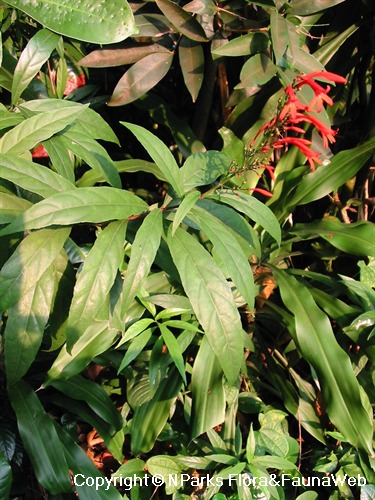
Back
Lobelia cardinalis
| Family Name: | Campanulaceae |
| Synonyms: | Lobelia splendens, Lobelia fulgens, Lobelia speciosa |
| Common Name: | Cardinal Flower, Indian Pink |
Name
Classifications and Characteristics
| Plant Division | Angiosperms (Flowering Seed Plants) (Dicotyledon) |
|---|---|
| Plant Growth Form | Shrub |
| Mode of Nutrition | Autotrophic |
| Maximum Height | 1.2 m |
Biogeography
| Native Distribution | South Canada to Northern Colombia |
|---|---|
| Native Habitat | Terrestrial |
Description and Ethnobotany
| Growth Form | Herbaceous plant growing up to 1.2 m tall. |
|---|---|
| Foliage | Dark green leaves are lanceolate with serrate leaf margin (10 - 15 cm long). |
| Flowers | Bright red, tubular flowers have a texture like velvet. They are bilabiate (having two lips) with the upper lip split in 2 parts and the lower in 3. Two whitish anthers are attached to the underside of the upper lip. There is a distinct bend in the tube of the flower, causing the opening of the flower to point to the ground. The flowers are arranged in a type of branching inflorescence called a panicle. |
| Habitat | Found in swamps and stream banks. |
| Associated Fauna | Pollinated by hummingbirds in its native habitat. |
| Etymology | This species is called the Cardinal Flower, because the bright red flowers are similar in colour to the garments worn by cardinals in the Catholic Church. |
| Ethnobotanical Uses | Medicinal: In traditional medicine, the roots are used to treat syphilis and intestinal disease, while the leaves are used to treat colds and bronchitis. |
Landscaping Features
| Desirable Plant Features | Ornamental Flowers |
|---|---|
| Landscape Uses | Marsh / Bog |
| Thematic Landscaping | Marsh Garden |
| Usage Hazard - Cons | Toxic Upon Ingestion |
Plant Care and Propagation
| Light Preference | Full Sun |
|---|---|
| Water Preference | Lots of Water |
| Plant Growth Rate | Moderate |
| Rootzone Tolerance | Waterlogged Soils |
| Propagation Method | Seed, Stem Cutting |
Foliar
| Foliage Retention | Evergreen |
|---|---|
| Mature Foliage Colour(s) | Green |
| Mature Foliage Texture(s) | Smooth |
| Foliar Type | Simple / Unifoliate |
| Foliar Attachment to Stem | Sessile |
| Foliar Shape(s) | Non-Palm Foliage (Lanceolate) |
| Foliar Venation | Pinnate / Net |
| Foliar Margin | Serrate / Toothed |
| Foliar Apex - Tip | Acute |
| Foliar Base | Attenuate |
| Typical Foliar Area | Mesophyll ( 45cm2 - 182.25 cm2 ) |
| Leaf Area Index (LAI) for Green Plot Ratio | 4.5 (Shrub & Groundcover - Dicot) |
Floral (Angiosperm)
| Flower Colour(s) | Red |
|---|---|
| Flower Texture(s) | Velvety / Furry / Tomentose |
| Flower Grouping | Cluster / Inflorescence |
| Flower Location | Terminal |
| Flower Symmetry | Bilateral |
| Individual Flower Shape | Tubular |
References
| References | Yong J, Tan PY, Nor Hafiz Hassan, Tan SN. 2010. A Selection of Plants for Greening of Waterways and Waterbodies in the Tropics. Singapore: Chung Printing . 480 pp. |
|---|
Image Repository
Others
| Master ID | 905 |
|---|---|
| Species ID | 2199 |
| Flora Disclaimer | The information in this website has been compiled from reliable sources, such as reference works on medicinal plants. It is not a substitute for medical advice or treatment and NParks does not purport to provide any medical advice. Readers should always consult his/her physician before using or consuming a plant for medicinal purposes. |



